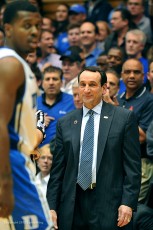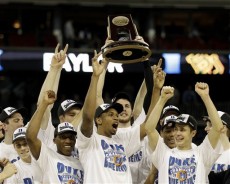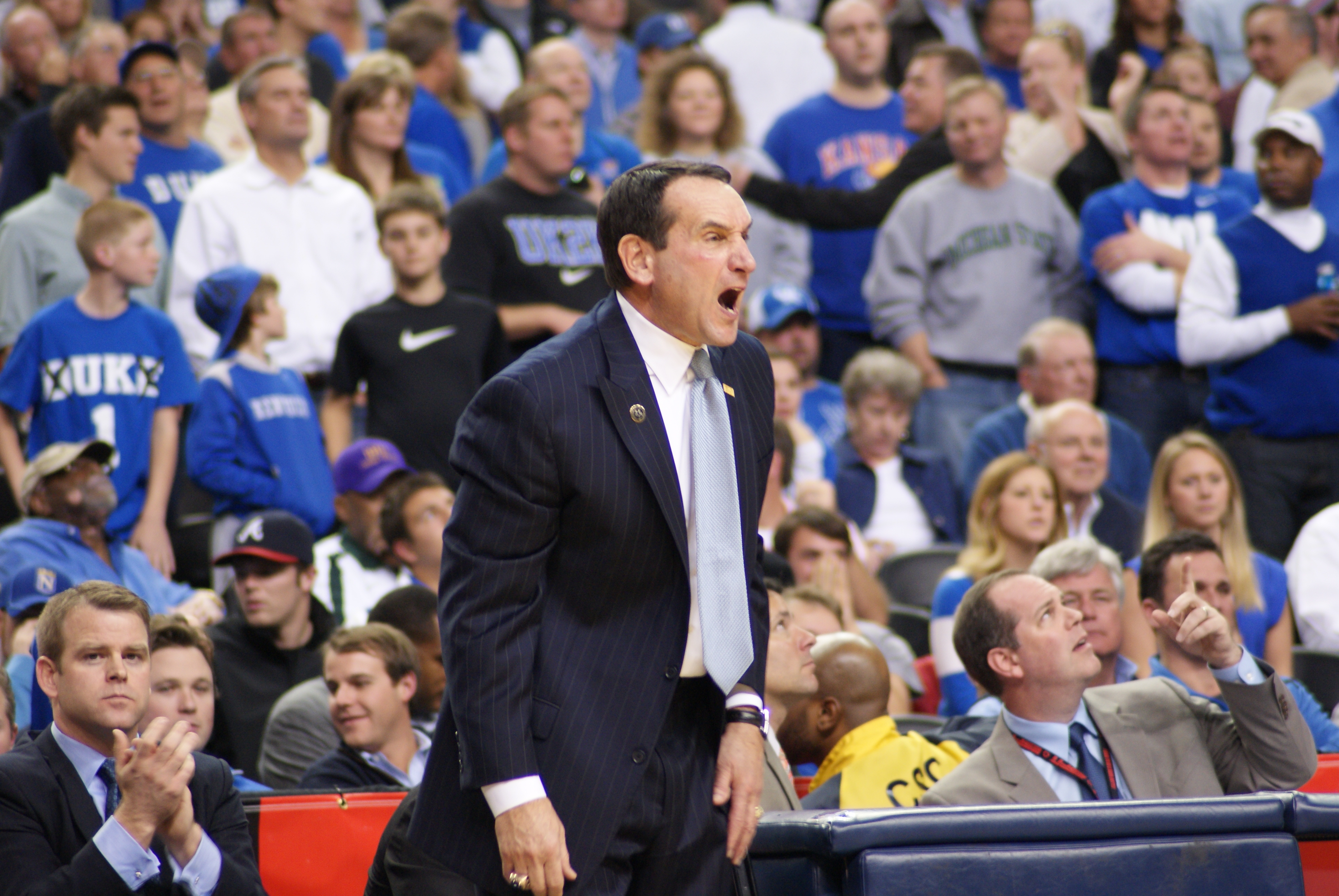 Seven Final Fours in nine years, 1986 to 1994. It's the period that vaulted Duke coach Mike Krzyzewski into the pantheon of the best college coaches, that moved Duke to the top of the teams-people-love-to-hate list, that prompted Duke fans to sport "Welcome to the Duke Invitational" buttons during the first weekend in April. It was a period of unparalleled NCAA tournament success the likes of which may never be seen again.
Seven Final Fours in nine years, 1986 to 1994. It's the period that vaulted Duke coach Mike Krzyzewski into the pantheon of the best college coaches, that moved Duke to the top of the teams-people-love-to-hate list, that prompted Duke fans to sport "Welcome to the Duke Invitational" buttons during the first weekend in April. It was a period of unparalleled NCAA tournament success the likes of which may never be seen again.
Which is a bit of a problem, because it has also become the standard against which many commentators and fans compare more recent Duke teams. We hear it every year around this time, at least for the past five years or so -- why does Duke seem to always "underperform" in the NCAA tournament? If you take out 2010, they say, Duke has not only failed to make the Final Four, the team has lost to a lower seeded team every year since 2004.
Well, first of all, of course you can't take out 2010. It happened in all it's wonderful glory. Still, it's hard to deny that in the past nine seasons, Duke's NCAA tournament record looks like an inverse of 1986 to 1994. From 2004 to 2012, Duke missed the Final Four in seven out of nine years.
So, what's the difference? Why did we do so well then and not so well now? As you might guess, theories have abounded. Many Duke fans like the "general awesomeness" theory, or as it is usually phrased, "we're just not as talented now as we were then." This theory has two problems with it. First, to be a meaningful comparison, you'd have to compare how talented the team is compared to the rest of NCAA teams. If the overall team talent level has decreased (due to increased early entry and the rise of the mid-major), then a straight up comparison is meaningless. Second, Duke's overall win/loss records in the two eras don't support this hypothesis. From 1986 to 1994, Duke won 264 games against 59 losses, while from 2004 to 2012, Duke had the same 264 wins but only 57 losses. Almost exactly the same.
That fact leads some to proclaim that Duke's regular season success is the "problem." The talent hasn't been as good but Duke's outstanding win/loss record and amazing recent ACC tournament success has led Duke to be "overseeded" in recent years, leading to disappointment in the Tournament. Or maybe it's the pressure of always playing as the hated favorite, with the entire house in supposedly neutral NCAA tournament venues cheering wildly for our opponent every single game?
Others suggest that Coach K has changed his coaching style, more concerned about winning every game rather than preparing for the NCAAs. He plays tighter rotations now, they say, leading to tired legs and undeveloped benches. The data, however, doesn't really support that theory, either. If you look at how many Duke players played 10+ minutes in non-blowouts (defined as end margins fewer than 20 points) after January 1, the average from 1986 to 1994 was 7.12 and the average from 2004 to 2012 was 7.02. So while the rotations are a bit tighter now than they were then, it's hard to imagine the one game a season where Duke had an eighth guy play 10 minutes would make any sort of a meaningful impact.
Of course it's possible that some or all of the above have truly made a difference. It's also possible, in my opinion probable, that the difference is mostly attributed to factors like poorly timed injuries and fluke performances, or small sample sizes and randomness in a single-elimination tournament.
In other words, luck.
Yes, luck. Things out of Duke's or Coach K's control. Many of these factors have been discussed at length, at least with regard to individual losses -- Ryan Kelly's injury in 2012; Derrick Williams otherworldly performance in 2011; the mysterious flu in 2008. And presumably most of these things had at least some effect on Duke's ability to advance.
 I'm going to suggest a different luck factor, one I've rarely seen discussed: Duke's path to the Final Four. Of all the factors, perhaps the most out of Duke's control. I'm not talking about Duke getting a "favorable draw," which has been discussed, ad nauseum, by those who think Duke's 2010 championship was somehow undeserved. No, I'm talking about upsets in earlier rounds, or lack thereof, which ultimately determined which teams Duke played in its tournament runs.
I'm going to suggest a different luck factor, one I've rarely seen discussed: Duke's path to the Final Four. Of all the factors, perhaps the most out of Duke's control. I'm not talking about Duke getting a "favorable draw," which has been discussed, ad nauseum, by those who think Duke's 2010 championship was somehow undeserved. No, I'm talking about upsets in earlier rounds, or lack thereof, which ultimately determined which teams Duke played in its tournament runs.
Duke's 1988 team, for example, was not considered a true national power. Top ten, perhaps, but not really a Final Four contender. After beating UNC for the third time that season in the ACC tournament final, Duke earned a #2 seed in the NCAA tournament. The Blue Devils dispatched 15th seeded Boston University and 7th seeded SMU, but instead of seeing 3rd seeded Syracuse in the Sweet 16, Duke faced an 11th seeded Rhode Island team that had narrowly defeated the much more highly regarded Orangemen. Duke's effort against Rhode Island was spotty, but the team held on to win by a single point before taking out #1 in the country Temple to make the Final Four. Would Duke have played better against Syracuse than they did against Rhode Island? We'll never know, but if not 1988 could have gone down as a Sweet 16 failure rather than a Final Four triumph.
In contrast, Duke's 2006 team held the top spot in the national polls for almost the entire season and entered the NCAAs as the tournament's top seed. Duke cruised by 16th seed Southern and 8th seed George Washington, and awaited its next opponent. The other side of the sub-bracket was a bit more interesting. 12th seeded Texas A&M upset 5th seeded Syracuse and held a two point lead against 4th seeded LSU with mere seconds to play, before LSU's Darrel Mitchell heaved a game-winning three-pointer from just inside the half-court line, giving LSU an improbable 58-57 victory. Of course in the next game, LSU's athletic defenders shut down JJ Redick, defeating Duke 62-54 before going on to beat a Texas team in the Regional final that Duke had beaten by 31 earlier in the season. If Mitchell's shot had rimmed out, would Duke have handled Texas A&M? Would the Devils then repeated their domination over Texas to make the Final Four? Again, none can say, but if not for a miracle at the buzzer maybe 2006 could have been a Final Four trip instead of a Sweet 16 flameout.
Well, one might say, those sort of things happen. It can't explain nine years of tournament domination vs. nine years of mostly early exits.
Or can it?
Obviously not entirely. But the fact is that from 1986 to 1994, in its Sweet 16 game Duke only played the team it was "supposed to" twice -- 1992 (when Duke beat 4th seeded Seton Hall before taking out Kentucky with Christian Laettner's miracle shot) and 1987 (when Duke lost to top seed Indiana). In 1993 3rd seeded Duke lost in the 2nd round (to the 6th seeded Cal team it was "supposed" to play), and the other six seasons involved Sweet 16 games against a #12 (instead of #4), three #11s (instead of #3s), a #7 (instead of #2) and a #6 (instead of #3). Would Coach K's squads have beaten the higher seeded teams the committee expected Duke to play? Maybe, but it sure was a lot easier after all those higher seeds were upset before they could get to Duke.
In contrast, from 2004 to 2012, every Sweet 16 game Duke played was against either the expected seed or one off (e.g., #5 instead of #4). Would those Duke "underachievers" advanced further if they'd been playing #11 or #12 seeds instead of #3 or #4? Again, it's impossible to say, but probaby at least a few of them would have. Interestingly enough, the only Duke team in the later time period that played any games against a seed more than one spot off from chalk was the 2004 team that beat 7th seeded Xavier (instead of #2 Mississippi State or #3 Texas) to reach one of Duke's two Final Fours in the period.
A full table is below:
1986 to 1994
| Year | Duke seed | Expected path | Actual Path | More than one off | Ratio of Actual to Expected |
| 1986 | 1 | 16-8-4-2 | 16-8-12-7 | 2 out of 4 games | 1.43 |
| 1987 | 5 | 12-4-1 | 12-13-1 | 1/3 | 1.53 |
| 1988 | 2 | 15-7-3-1 | 15-7-11-1 | 1/4 | 1.31 |
| 1989 | 2 | 15-7-3-1 | 15-7-11-1 | 1/4 | 1.31 |
| 1990 | 3 | 14-6-2-1 | 14-6-7-1 | 1/4 | 1.22 |
| 1991 | 2 | 15-7-3-1 | 15-7-11-4 | 2/4 | 1.42 |
| 1992 | 1 | 16-8-4-2 | 16-9-4-2 | 0/4 | 1.03 |
| 1993 | 3 | 14-6 | 14-6 | 0/2 | 1.00 |
| 1994 | 2 | 15-7-3-1 | 15-7-6-1 | 1/4 | 1.12 |
2004 to 2012
| Year | Duke seed | Expected path | Actual Path | More than one off | Ratio of Actual to Expected |
| 2004 | 1 | 16-8-4-2 | 16-8-5-7 | 1 out of 4 games | 1.20 |
| 2005 | 1 | 16-8-4 | 16-9-5 | 0/3 | 1.07 |
| 2006 | 1 | 16-8-4 | 16-8-4 | 0/3 | 1.00 |
| 2007 | 6 | 11 | 11 | 0/1 | 1.00 |
| 2008 | 2 | 15-7 | 15-7 | 0/2 | 1.00 |
| 2009 | 2 | 15-7-3 | 15-7-3 | 0/3 | 1.00 |
| 2010 | 1 | 16-8-4-2 | 16-8-4-3 | 0/4 | 1.03 |
| 2011 | 1 | 16-8-4 | 16-8-5 | 0/3 | 1.04 |
| 2012 | 2 | 15 | 15 | 0/1 | 1.00 |
Both time periods included one season (interestingly, the 7th season in the 9 year period in both cases) where Duke played through chalk to win the national championship. Also, in 1987, 5th seeded Duke breezed through an easy path to get to the Sweet 16 and couldn't handle eventual national champion Indiana. Other than those seasons, however, every time the ratio of actual to expected path was above 1.1, Duke made the Final Four and every time it was below 1.1 Duke lost to a lower seeded team. Coincidence? Maybe. It's still a very small sample. But possibly it's a factor in explaining why Duke has seemed to stall in the Sweet 16 in recent years.
What does all this mean for this year's NCAA tournament? Probably nothing. The past doesn't necessarily define the future. But at least it'll give us all one more thing to think about while we watch the final steps of this Duke team's journey.
Oh, and also, Duke fans might want to root for Cincinnati and Valparaiso, just in case.

You must be logged in to post a comment.